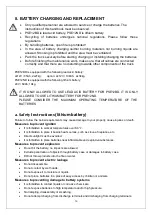
15
b. Residual lift diagram
The residual lift diagram indicates the maximum capacity Q [kg] for a given load centre c [mm] and the
corresponding lift height H [mm] for the truck with horizontal load.
The white markings on the mast indicate if the specific lifting limits reached. For instance (Fig.9. left)
with a load centre of gravity distance c of 600 mm and a maximum lift height H of 3600 mm, the max.
Capacity Q is 700 kg. Fig. 9. right shows when the truck is used as pallet truck and stacker at the same
time, the load capacity of fork and pallet is both 600kg, so the total load capacity is 1200kg. When the
fork lift height is within 120mm, the maximum stack height is 1800mm.
c. Lifting
DO NOT OVERLOAD THE TRUCK! THE MAXIMUM
CAPACITY IS 1200kg.
LIFT ONLY CAPACITIES ACCORDING TO THE
RESIDUAL LIFT DIAGRAM.
Travel with the lowered forks fully underneath the pallet and press
the lifting button (Fig. 7, 31) until you reached the desired lifting
height.
This truck can be used as pallet truck and stacker.
When press the fork lift button (Fig. 7, 31), the fork and pallet lift together, the maximum lift height is 120
mm, maximum load is 1200 kg.
When the fork lifts to the height within 120 mm, press the pallet lift button (Fig. 7, 28), the pallet lifts for
stacking, the maximum stack height is 1800 mm (the truck is used as pallet truck and stacker at the
same time).
When stack height is more than 1800 mm, the fork can't lift (the truck is only used as stacker).
d. Lowering
If the forks are in the racking, firstly travel out of the racking carefully with or without the pallet. By travelling
out of the racking, take care that the forks are not touching the racking.
Press the lowering button (Fig. 7, 29) carefully.
Lower the load until the forks are clear of the pallet, then drive the truck carefully out of the load unit.
Fig.10: Load facing uphill








































